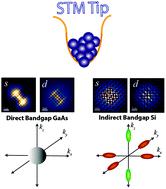Our official English website, www.x-mol.net, welcomes your
feedback! (Note: you will need to create a separate account there.)
Influence of sample momentum space features on scanning tunnelling microscope measurements
Nanoscale ( IF 5.8 ) Pub Date : 2021-09-17 , DOI: 10.1039/d1nr04858a Maxwell T West 1 , Muhammad Usman 1, 2
Nanoscale ( IF 5.8 ) Pub Date : 2021-09-17 , DOI: 10.1039/d1nr04858a Maxwell T West 1 , Muhammad Usman 1, 2
Affiliation

|
Theoretical understanding of scanning tunnelling microscopy (STM) measurements involve electronic structure details of the STM tip and the sample being measured. Conventionally, the focus has been on the accuracy of the electronic state simulations of the sample, whereas the STM tip electronic state is typically approximated as a simple spherically symmetric s orbital. This widely used s orbital approximation has failed in recent STM studies where the measured STM images of subsurface impurity wave functions in silicon required a detailed description of the STM tip electronic state. In this work, we show that the failure of the s orbital approximation is due to the indirect band-gap of the sample material silicon (Si), which gives rise to complex valley interferences in the momentum space of impurity wave functions. Based on direct comparison of STM images computed from multi-million-atom electronic structure calculations of impurity wave functions in direct (GaAs) and indirect (Si) band-gap materials, our results establish that whilst the selection of STM tip orbital only plays a minor qualitative role for the direct band gap GaAs material, the STM measurements are dramatically modified by the momentum space features of the indirect band gap Si material, thereby requiring a quantitative representation of the STM tip orbital configuration. Our work provides new insights to understand future STM studies of semiconductor materials based on their momentum space features, which will be important for the design and implementation of emerging technologies in the areas of quantum computing, photonics, spintronics and valleytronics.
中文翻译:

样品动量空间特征对扫描隧道显微镜测量的影响
扫描隧道显微镜 (STM) 测量的理论理解涉及 STM 尖端和被测量样品的电子结构细节。通常,重点是样品电子状态模拟的准确性,而 STM 尖端电子状态通常近似为简单的球对称 s 轨道。这种广泛使用的 s 轨道近似在最近的 STM 研究中失败,其中硅中地下杂质波函数的测量 STM 图像需要对 STM 尖端电子状态的详细描述。在这项工作中,我们表明 s 轨道近似的失败是由于样品材料硅 (Si) 的间接带隙,这会在杂质波函数的动量空间中产生复杂的谷干涉。基于直接(GaAs)和间接(Si)带隙材料中杂质波函数的数百万原子电子结构计算得到的 STM 图像的直接比较,我们的结果表明,虽然 STM 尖端轨道的选择仅起到直接带隙 GaAs 材料的次要定性作用,间接带隙 Si 材料的动量空间特征极大地改变了 STM 测量,因此需要定量表示 STM 尖端轨道配置。我们的工作为理解基于动量空间特征的半导体材料未来的 STM 研究提供了新的见解,这对于量子计算、光子学、自旋电子学和谷电子学领域的新兴技术的设计和实施非常重要。
更新日期:2021-09-22
中文翻译:

样品动量空间特征对扫描隧道显微镜测量的影响
扫描隧道显微镜 (STM) 测量的理论理解涉及 STM 尖端和被测量样品的电子结构细节。通常,重点是样品电子状态模拟的准确性,而 STM 尖端电子状态通常近似为简单的球对称 s 轨道。这种广泛使用的 s 轨道近似在最近的 STM 研究中失败,其中硅中地下杂质波函数的测量 STM 图像需要对 STM 尖端电子状态的详细描述。在这项工作中,我们表明 s 轨道近似的失败是由于样品材料硅 (Si) 的间接带隙,这会在杂质波函数的动量空间中产生复杂的谷干涉。基于直接(GaAs)和间接(Si)带隙材料中杂质波函数的数百万原子电子结构计算得到的 STM 图像的直接比较,我们的结果表明,虽然 STM 尖端轨道的选择仅起到直接带隙 GaAs 材料的次要定性作用,间接带隙 Si 材料的动量空间特征极大地改变了 STM 测量,因此需要定量表示 STM 尖端轨道配置。我们的工作为理解基于动量空间特征的半导体材料未来的 STM 研究提供了新的见解,这对于量子计算、光子学、自旋电子学和谷电子学领域的新兴技术的设计和实施非常重要。











































 京公网安备 11010802027423号
京公网安备 11010802027423号